Art From South American Studied in This Chapter Is Known as

Latin American fine art is the combined creative expression of South America, Central America, the Caribbean area, and Mexico, as well equally Latin Americans living in other regions.
The art has roots in the many different indigenous cultures that inhabited the Americas before European colonization in the 16th century. The indigenous cultures each developed sophisticated artistic disciplines, which were highly influenced by religious and spiritual concerns. Their piece of work is collectively known and referred to as Pre-Columbian art. The blending of Amerindian, European and African cultures has resulted in a unique Mestizo tradition.
Colonial flow [edit]
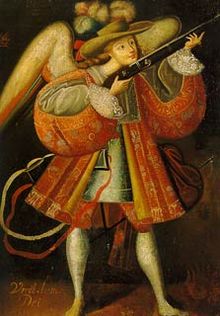
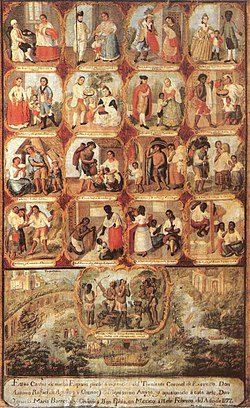
Single canvass depiction of the casta arrangement of racial hierarchy in eighteenth-century Mexico, by Ignacio María Barreda. Most sets of casta paintings were individual canvases showing but i family unit.
During the colonial menses, a mixture of indigenous traditions and European influences (mainly due to the Christian teachings of Franciscan, Augustinian and Dominican friars) produced a very particular Christian fine art known as Indochristian art. In add-on to indigenous art, the development of Latin American visual fine art was significantly influenced by Spanish, Portuguese, and French and Dutch Bizarre painting. In turn Baroque painting was often influenced by the Italian masters.
The Cuzco Schoolhouse is viewed as the first middle of European-mode painting in the Americas. In the 17th and 18th centuries, Spanish fine art instructors taught Quechua artists to paint religious imagery based on classical and Renaissance styles.[1]
In eighteenth-century New Spain, Mexican artists along with a few Spanish artists produced paintings of a organisation of racial hierarchy, known equally casta paintings. It was almost exclusively a Mexican form yet, one prepare was produced in Peru. In a break from religious paintings of the preceding centuries, casta paintings were a secular art form. Only 1 known casta painting by a relatively unknown painter, Luis de Mena, combines castas with Mexico'due south Virgin of Guadalupe; this existence an exception. Some of United mexican states's nearly distinguished artists painted casta works, including Miguel Cabrera. Nigh casta paintings were on multiple canvases, with i family unit grouping on each. There were a handful of unmarried canvas paintings, showing the entire racial hierarchy. The paintings show idealized family groupings, with the male parent being of i racial, the mother of another racial category, and their offspring being a 3rd racial category. This genre of painting flourished for most a century, coming to an end with Mexican independence in 1821, and the abolition of legal racial categories.[2]
In the seventeenth century, The Netherlands had captured the rich sugar-producing area of the Portuguese colony of Brazil (1630–1654). During that period, Dutch artist Albert Eckhout painted a number of important depictions of social types in Brazil. These depictions included images of indigenous men and women, as well as withal lifes.[iii]
Scientific expeditions approved by the Castilian crown began exploring Spanish America where its flora and animate being were recorded. Spaniard José Celestino Mutis, a medical doctor and horticulturalist and follower of Swedish scientist Carl Linnaeus, led an expedition starting in 1784 to northern South America, the expedition is known as the Expedición Botánica de Nueva Granada. Local artists were Ecuadorean Indians, who produced 5 grand color drawings of nature, all beingness published. The crown chartered expedition whose purpose was scientific recording of the natural beauty and wealth of Nature, was a departure from the long traditional religious art.[iv]
The most of import scientific trek was that of Alexander von Humboldt and French botanist Aimé Bonpland. They traveled for five years throughout Castilian America (1799-1804), exploring and recording scientific information too as the attire and lifestyles local populations.[5] Humboldt's piece of work became an inspiration and template for continuing scientific work in the nineteenth century, every bit well every bit traveller reporters who recorded the scenes of everyday life.
In 1818, the University of San Alejandro in Havana, Republic of cuba, was founded by the French painter Jean Baptiste Vermay,[6] making it the oldest academy of art in Latin America.[seven]
Historiography of colonial art and architecture [edit]
The history of Latin American art has more often than not been written by those with grooming in art history departments. Yet, the concept of "visual culture" has at present brought scholars trained in other disciplines to write the histories of art. As with the history of indigenous peoples, for many years in that location was a focus on either the pre-Columbian catamenia (Olmec, Maya, Aztec, Inca) fine art production, then a leap to the twentieth century. More recently, the colonial era and the nineteenth century have developed as fields of focus. Visual civilisation as a field increasingly crosses disciplinary boundaries. Colonial architecture has been the subject area of a number of important studies.[8] [9] [10] [11] [12] [thirteen]
Colonial fine art has a long tradition, especially in Mexico, with at that place being publications of Manuel Toussaint.[14] In contempo years, there has been a boom in publications on colonial art, with some useful overviews being published in recent years.[15] [16] [17] [18] [xix] [20] Many works bargain exclusively with Spanish America.
Major exhibitions on colonial art accept resulted in fine catalogs as a permanent record.[21] [22] [23] [24] [25] [26] [27]
Gallery [edit]
-

-

The Marriage of Captain Martin de Loyola to Beatriz Ñusta, particular, c. 1675–1690, Church of la Compañía de Jesús, Cuzco, Peru.
-

Our Lady of Bethelem, Peru, anonymous, 18th century
-

-

Vicente Alban. Spanish woman and her black slave. Quito, 18th century
-

Mestizo, Mestiza, Mestizo Peruvian casta painting, showing intermarriage within a casta category. 18th c.
-

Miguel Cabrera (Mexico) Casta painting, From Spaniard and Mulatta, Morisca. Oil on sheet. Private collection. 18th c.
-

Aleijadinho(Brazil): Angel of the Passion, ca. 1799. Congonhas do Campo
Nineteenth-century [edit]
Gallery – Foreign artists in Latin America [edit]
-

Jean Baptiste Debret (French) "L'execution de la Punition du Fouet" ("Execution of the Penalty of the Whip") (Brazil)
-

Jean Baptiste Debret (French) "Feitors corrigeant des negres" ("Plantation overseers disciplining blacks") Brazil
-

Carl Nebel (German) Las Tortilleras, Voyage pittoresque et archéologique dans la partie la plus intéressante du Mexique. Mexico. Early 19th c.
-

-

Gallery – Latin American artists [edit]
-

Carmelo Fernández (Venezuela). Muleteer and Lid Weaver in Vélez. 1850. watercolor. National Library of Colombia
-

-

-

-

-

-

Pedro Weingartner (Brazil). Subsequently the Inundation Meseu Nacional de Belas Artes, Rio de Janeiro
-

Agustín Arrieta, El Costeño. Private collection. The painting shows a male child from the coast, likely Veracruz, holding a handbasket of fruits including mamey, tuna and pitahaya
Modernism [edit]

La Muerte de Girardot en Bárbula, past Venezuelan painter Cristóbal Rojas, oil, 1883
Modernism, a Western fine art movement typified by the rejection of traditional classical styles. This movement holds an ambivalent position in Latin American art. Not all countries developed modernized urban centers at the same time, and then Modernism's appearance in Latin America is difficult to engagement. While Modernism was welcomed past some, others rejected information technology. Generally speaking, the countries of the Southern Cone were more open up to foreign influence, while countries with a stronger indigenous presence such as United mexican states, Republic of peru, Ecuador, and Bolivia were resistant to European civilization.[28]
A landmark event for Modernism in the region was, the Semana de Arte Moderna or Modern Fine art Calendar week, a festival that took place in São Paulo, Brazil, in 1922, mark the starting time of Brazil's Modernismo motion. "[T]hough a number of individual Brazilian artists were doing modernist work before the Week, information technology coalesced and divers the movement and introduced it to Brazilian society at large."[ citation needed ]
Constructivist movement [edit]
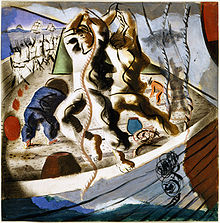
In full general, the creative Eurocentrism associated with the colonial period began to fade in the early on twentieth century, as Latin Americans began to admit their unique identity and started to follow their ain path.
From the early twentieth century onward, the art of Latin America was greatly inspired by Constructivism.[ citation needed ] It chop-chop spread from Russia to Europe, and then into Latin America. Joaquín Torres García and Manuel Rendón take been credited with bringing the constructivism to Latin America.[ commendation needed ]
Afterwards a long and successful career in Europe and the United States, Torres García returned to his native Uruguay in 1934, where he both promoted Constructivism and augmented it into a uniquely Uruguayan movement: Universal Constructivism. Attracting a circle of experienced peers and immature artists as followers in Montevideo, in 1935 he founded the Asociación de Arte Constructivo every bit an art center and exhibition space for his circle. The venue was closed in 1940 due to a lack of funding. In 1943, he opened the Taller Torres-García, a workshop and training center that operated until 1962.[29]
Muralism [edit]

Muralism or Muralismo is an important artistic move generated in Latin America. It is popularly represented by the Mexican muralism movement of Diego Rivera, David Alfaro Siqueiros, José Clemente Orozco, and Rufino Tamayo. In Chile, José Venturelli and Pedro Nel Gómez were influential muralists. Santiago Martinez Delgado championed muralism in Colombia, as did Gabriel Bracho in Venezuela. In the Dominican Democracy, Spanish exile José Vela Zanetti was a prolific muralist, painting over 100 murals in the country. The Ecuadorian creative person Oswaldo Guayasamín (a student of Orozco), the Brazilian Candido Portinari, and Bolivian Miguel Alandia Pantoja are also noteworthy. Some of the most impressive Muralista works can be found in Mexico, Republic of colombia, New York, San Francisco, Los Angeles, Chicago and Philadelphia. Mexican Muralism "enjoyed a type of prestige and influence in other countries that no other American fine art move had e'er experienced."[xxx] Through Muralism, artists in Latin America found a distinctive fine art form that provided for political and cultural expression, often focusing on issues of social justice related to their ethnic roots.[28]
Generación de la Ruptura [edit]
Generación de la Ruptura, or "Rupture Generation," (sometimes just known as "Ruptura") is the name given to an art motility in Mexico in the 1960s in which younger artists broke away from the established national style of Muralismo. Born out of the desire of younger artists for greater freedom of style in art, this movement is marked by expressionistic and figurative styles. Mexican artist José Luis Cuevas is credited with initiating the Ruptura. In 1958, Cuevas published a newspaper called La Cortina del Nopal ("The Cactus Pall"), which condemned Mexican muralism as overly political, calling information technology "inexpensive journalism and harangue" rather than art.[28] Representative artists include José Luis Cuevas, Alberto Gironella, and Rafael Coronel.
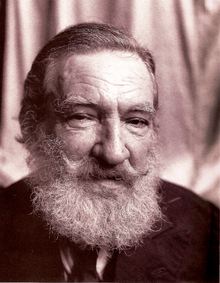
Armando Reverón is ane of the most important painters of the century in Latin America
Nueva Presencia [edit]
Nueva Presencia ("new presence") was an artist group founded by artists Arnold Belkin and Francisco Icaza in the early 1960s. In response to WWII atrocities such every bit the Holocaust and the diminutive bomb, the artists of Nueva Presencia shared an anti-aesthetic rejection of gimmicky trends in art and believed that the artist had a social responsibleness. Their beliefs were outlined in the Nueva Presencia manifesto, which was published in the first issue of the poster review of the aforementioned name. "No one, particularly the artist, has the correct to be indifferent to the social order."[29] Members of the group included Francisco Corzas (b. 1936), Emilio Ortiz (b. 1936), Leonel Góngora (b.1933), Artemio Sepúlveda (b. 1936), and José Muñoz, and lensman Ignacio "Nacho" López.
Surrealism [edit]
The French poet and founder of Surrealism, André Breton, after visiting Mexico in 1938, proclaimed it to exist "the surrealist country par excellence."[29] Surrealism, an artistic movement originating in post-World War I Europe, strongly impacted the art of Latin America. This is where the Mestizo culture, the legacy of European conquer over ethnic peoples, embodies contradiction, a key value of Surrealism.[31]
The widely known Mexican painter Frida Kahlo painted self-portraits and depictions of traditional Mexican culture in a style that combines Realism, Symbolism and Surrealism. Although, Kahlo did non commend this label, in one case saying, "They thought I was a Surrealist, but I wasn't. I never painted dreams. I painted my ain reality."[32] Kahlo'southward work commands the highest selling price of all Latin American paintings, and the second-highest for any female artist.[33] Other female Mexican Surrealists include Leonora Carrington (a British woman who relocated to Mexico) and Remedios Varo (a Spanish exile). Mexican creative person Alberto Gironella, Chilean artists Roberto Matta, Mario Carreño Morales, and Nemesio Antúnez, Cuban creative person Wifredo Lam, and Argentinean artist Roberto Aizenberg have also been classified as Surrealists.
Gimmicky Art [edit]
Since roughly the 1970s, artists from all parts of Latin America have made important contributions to international contemporary art, from conceptual sculptors similar Doris Salcedo (from Colombia) and Daniel Lind-Ramos (from Puerto Rico), to painters like Myrna Báez (from Puerto Rico), to artists working in media like photography, such every bit Vik Muniz (from Brazil).
Styles and trends [edit]
Figuration [edit]
European classical art styles have fabricated a long-lasting impression on the fine art of Latin America. Into the twentieth century, many Latin American artists continued to be schooled in the traditional 19th-century fashion, resulting in a continued emphasis on figurative work. Due to the far achieve of figuration, the work often spans upon a number of dissimilar styles such as Realism, Pop art, Expressionism, and Surrealism, only naming a few. While these artists face issues that range from the personal to the political, many have a shared interest in indigenous issues and the heritage of European cultural imperialism.
Ane movement devoted to figuration was Otra Figuración (Other Figuration), an Argentine artist group and commune formed in 1961 and disbanded in 1966. Members Rómulo Macció, Ernesto Deira, Jorge de la Vega, and Luis Felipe Noé lived together and shared a studio in Buenos Aires. Artists of Otra Figuración worked in an expressionistic abstract figurative style featuring brilliant colors and collage. Although Otra Figuración were contemporaries of Nueva Presencia, at that place was no direct contact between the two groups.[29] People who are sometimes associated with the grouping are Raquel Forner, Antonio Berni, Alberto Heredia, and Antonio Seguí.
Parody and sociopolitical critique [edit]

Fine art in Latin America has often been used equally a ways of social and political critique. Mexican graphic creative person José Guadalupe Posada drew harsh images of Mexican elites as skeletons, calaveras. This was done prior to the Mexican Revolution, strongly influencing subsequently artists, such every bit Diego Rivera. A common exercise amongst Latin American figurative artists is to parody Old Master paintings, especially those of the Spanish court produced by Diego Velázquez in the 17th century. These parodies serve a dual purpose, referring to the artistic and cultural history of Latin America, and critiquing the legacy of European cultural imperialism in Latin American nations. Ii notable artists who oftentimes employed this technique are Fernando Botero and Alberto Gironella.
Colombian figurative creative person Fernando Botero, whose work features unique "puffy" figures in various situations addressing themes of power, war, and social issues, has used this technique to draw parallels between current governing bodies and the Spanish monarchy. His 1967 painting The Presidential Family unit, is an early on example. The painting, echoing Diego Velázquez's 1656 Spanish courtroom painting Las Meninas (The Maids of Honor), contains a self-portrait of Botero standing behind a big canvas. The thick, "puffy" presidential family, decked out in stylish finery and staring blandly out of the canvas, appear socially superior, drawing attention to social inequality.[31] Co-ordinate to Botero, his "puffy" figures are not meant to be satirical. He painted a powerful series of canvases, which are based on photos of torture by the U.S. armed forces of Iraqi prisoners at Abu Ghraib prison. .
- The deformation you lot see is the event of my involvement with painting. The monumental and, in my eyes, sensually provocative volumes stem from this. Whether they appear fat or non does non interest me. It has inappreciably any meaning for my painting. My concern is with formal fullness, affluence. And that is something entirely different. [28]
Mexican painter and collagist Alberto Gironella, whose style mixes elements of Surrealism and Pop art, also produced parodies of official Spanish court paintings. He completed dozens of versions of Velásquez'due south Queen Mariana from 1652. Gironella's parodies critique the Spanish dominion of United mexican states past incorporating subversive imagery. ''La Reina de los Yugos'' or "The Queen of Yokes" (1975–81) depicts Mariana with a brim made of upside-down ox yokes, signifying both Castilian dominance over Mexico'due south indigenous peoples, and those people's subversion of Spanish dominion. The yokes are rendered useless past being upturned. "[Gironella'due south] hallmark was the utilise of particular Castilian Grocery cans (sardines, mussels, etc.) in his works, and soda bottle caps nailed or glued around the rim of his paintings."
Cuban creative person Sandra Ramos' paintings, etchings, installations, collages, and digital animation ofttimes tackle taboo subjects in contemporary Cuban society such every bit racism, mass migration, communism and social injustices in gimmicky Cuban society.[34] [35]
Photography [edit]
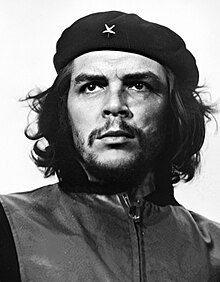
Photographers captured on film, indigenous peoples every bit well equally distinct social types, such as the gauchos of Argentina. A number of Latin Americans have made meaning contributions to modern photography. Guy Veloso and José Bassit photograph the Brazilian religiosity. Guillermo Kahlo photographed Mexican colonial buildings and infrastructure, such as the railway span at Metlac. Agustín Casasola himself took many images of the Mexican Revolution, and compiled an extensive archive of Mexican photos. Other photographers include indigenous Peruvian Martín Chambi, Mexican Graciela Iturbide, and Cuban Alberto Korda, famous for his iconic prototype of Che Guevara. Mario Testino is a noted Peruvian way photographer. In addition, a number of non-Latin American photographers take focused on the surface area, including Tina Modotti and Edward Weston in Mexico. Guatemalan national María Cristina Orive has worked in Argentina with Sara Facio. Ecuadoran Hugo Cifuentes has garnered attending.
Gallery [edit]
-

Photo of an Argentine gaucho. Courret Hermanos Fotogs., Lima, Peru (1868)
-

Martín Chambi (Peru) photograph of a human at Machu Picchu, published in Inca Country. Explorations in the Highlands of Peru, 1922
See also [edit]
- Visual arts by indigenous peoples of S America
- Fine art of Colombia
- Art in Puerto Rico
- Art of Venezuela
- Indochristian fine art
- Brazilian art
- Chilean art
- Cuban art
- Culture of Mexico
- Mexican art
- Mexican Muralism
- Culture of Panama
- Chilote School of Religious Imagery
- Latin American culture
- List of Ecuadorian artists
- List of Latin American artists
- Paraguayan Indian fine art
- Civilization of Peru
- Peruvian fine art
- Pre-Columbian art
References [edit]
- ^ The "Cusquenha" Art. Archived 2016-05-05 at the Wayback Machine Museu Histórico Nacional. (retrieved xxx April 2009)
- ^ Ilona Katzew, Casta Painting, New Haven: Yale University Printing 2005.
- ^ Dawn Ades, "Nature, Science, and the Picturesque" in Art in Latin America: The Modern Era, 1820–1980, London: South Bank Eye 1989, 64–65.
- ^ Stanton L. Catlin, "Traveller-Reporter Artists and the Empirical tradition in Mail Independence Latin American Art" in Art in Latin America: The Modernistic Era, 1820-1980, London: South Bank Center 1989, pp. 43-45, color plate 3.2 p. 44.
- ^ Alexander von Humboldt, Voyage de Humboldt et de Bonpland, Première Partie; Relation Historique: Atlas Pittoresque: 'Vues de Cordillères et monuments de peuples indigènes de 50'Amérique', Paris 1810.
- ^ WPnew (2018-11-27). "Art Schools: San Alejandro University". InterfineArt . Retrieved 2020-03-25 .
- ^ "Cuban Art: History & Artists". Study.com . Retrieved 2020-03-25 .
- ^ George Kubler, Mexican Compages of the Sixteenth Century. 2 vols. New Haven: Yale University Press 1948.
- ^ John McAndrew, The Open-Air Churches of Sixteenth-Century Mexico: Atrios, Posas, Open Chapels, and Other Studies. Cambridge: Harvard University Printing 1965.
- ^ James Early, The Colonial Compages of United mexican states. Albuquerque: Academy of New Mexico Printing 1994.
- ^ James Early, Presidio, Mission, and Pueblo: Spanish Architecture and Urbanism in the United States. Dallas: Southern Methodist University Press 2004.
- ^ Valerie Fraser. The Architecture of Conquest: Building in the Viceroyalty of Peru, 1535–1635. Cambridge: Cambridge University Printing 1989.
- ^ Harold Wethey, Colonial Compages and Sculpture in Republic of peru. Cambridge: Harvard University Press 1949.
- ^ Manuel Toussaint, Arte colonial en México. Mexico: Universidad Nacional Autónoma de México, Instituto de Investigaciones Estéticas, 1948. 5th edition 1990.
- ^ Damian Bayon and Murrillo Marx, History of South American Colonial Art and Compages. New York: Rizzoli 1989.
- ^ Marcus Burke, Treasures of Mexican Colonial Painting. Davenport IA: The Davenport Museum of Art 1998.
- ^ Richard Kagan, Urban Images of the Hispanic Earth, 1493–1793. New Haven: Yale University Press 2000.
- ^ Gauvin Alexander Bailey, Art of Colonial Latin America. London: Phaidon 2005
- ^ Kelly Donahue-Wallace, Art and Architecture of Viceregal Latin America, 1521–1821. Albuquerque: University of New United mexican states Press 2008.
- ^ Emily Umbeger and Tom Cummins, eds.Native Artists and Patrons in Colonial Spanish America. Phoebus: A Journal of Art History. Phoenix: Arizona State University 1995.
- ^ Linda Bantel and Marcus Shush, Spain and New Espana: Mexican Colonial Arts in their European Context. Exhibition catalog. Corpus Christi TX: Fine art Museum of South Texas 1979.
- ^ María Concepción García Sáiz, Las castas mexicanas: Un género pictórico americano. Milan: Olivetti 1989.
- ^ New World Orders: Casta Painting and Colonial Latin America. Exhibition catalog. New York: Americas Club Art Gallery 1996.
- ^ Diana Fane, ed. Converging Cultures: Art and Identity in Spanish America. Exhibition catalog. New York: The Brooklyn Museum in association with Harry Due north. Abrams. 1996.
- ^ Los Siglos de oro en los Virreinatos de América 1550–1700. Exhibition itemize. Madrid: Sociedad Estatal para la Conmemoración de los Centenarios de Felipe Ii y Carlos Five, 1999.
- ^ Donna Pierce et al., Painting a New World: Mexican Art and Life 1521–1821. Exhibition catalog. Denver: Denver Art Museum 2004.
- ^ The Arts in Latin America: 1492–1820. Exhibition catalog. Philadelphia: Philadelphia Museum of Fine art 2006.
- ^ a b c d Lucie-Smith, Edward. Latin American Art of the 20th Century. London: Thames and Hudson Ltd, 1993.
- ^ a b c d Barnitz, Jacqueline. Twentieth Century Art of Latin America. Austin, TX: University of Texas Press, 2001.
- ^ Sullivan, Edward. Latin American Art. London: Phaidon Press, 2000. ISBN 978-0-7148-3980-half dozen
- ^ a b Baddeley, Oriana & Fraser, Valerie. Cartoon the Line: Art and Cultural Identity in Contemporary Latin America. London: Verso, 1989.
- ^ "Frida Kahlo - Surrealist Conflict | PDF | Surrealism | Paintings".
- ^ Moses, Tai. Saint Frida. MetroActive: Books. 9 November 2005 (retrieved 18 April 2009)
- ^ "Bridging By, Present, and Future: A Conversation with Cuban Artist Sandra Ramos | Kellogg Establish For International Studies". Kellog Found at The University of Notre Matriarch. 2017-11-06. Retrieved 2020-03-25 .
- ^ Staff, AiA (2010-10-07). "United states Welcomes Cuban Artists". ARTnews.com . Retrieved 2020-03-25 .
Further reading [edit]
- Ades, Dawn. Art in Latin America: The Modern Era, 1820-1980. New Oasis: Yale Academy Press 1989.
- Alcalá, Luisa Elena and Jonathan Brown. Painting in Latin America: 1550-1820. New Haven: Yale Academy Press 2014.
- Angulo-Iñiguez, Diego, et al. Historia del Arte Hispano-Americano. 3 vols. (Barcelona 1945-56).
- Anreus, Alejandro, Diana L. Linden, and Jonathan Weinberg, eds. The Social and the Existent: Political Fine art of the 1930s in the Western Hemisphere. Academy Park: Penn State University Press 2006.
- Baddeley, Oriana; Fraser, Valerie (1989). Drawing the Line: Fine art and Cultural Identity in Contemporary Latin America. London: Verso. ISBN0-86091-239-six.
- Bailey, Gauvin Alexander. Fine art of Colonial Latin America. New York: Phaidon Press 2005.[1]
- Barnitz, Jacqueline. Twentieth-Century Art of Latin America. Austin: Academy of Texas Press 2001.
- Bayón, D. and Thou. Marx. History of Due south American Colonial Fine art and Compages. New York 1992.
- Bottineau, Yves. Iberian-American Baroque. New York 1970.
- Cali, François. The Castilian Arts of Latin America. New York 1961.
- Castedo, Leopoldo. A History of Latin American Fine art and Compages. New York and Washington, D.C. 1969.
- Craven, David. Art and Revolution in Latin America, 1910-1990. New Haven: Yale University Press 2002.
- Dean, Carolyn and Dana Leibsohn, "Hybridity and Its Discontents: Because Visual Culture in Colonial Castilian America," Colonial Latin American Review, vol. 12, No. i, 2003.
- del Conde, Teresa (1996). Latin American Fine art in the Twentieth Century. London: Phaidon Press Limited. ISBN0-7148-3980-ix.
- Donahue-Wallace, Kelly. Fine art and Compages of Viceregal Latin America, 1521-1821. Albuquerque: University of New United mexican states Press 2008.
- Fane, Diana, ed. Converging Cultures: Art and Identity in Spanish America. (exhibition catalogue Brooklyn Museum of Fine art 1996.
- Fernández, Justino (1965). Mexican Fine art. Mexico D.F.: Jump Books.
- Frank, Patrick, ed. Readings in Latin American Mod Art. New Haven: Yale University Press 2004.
- Goldman, Shifra M. Dimensions of the Americas: Art and Social Change in Latin America and the United states. Chicago: Academy of Chicago Press 1994.
- Isabella Stewart Gardner Museum. The Give-and-take Made Image: Religion, Art, and Architecture in Espana and Spanish America, 1500-1600. Boston 1998.
- Kagan, Richard. Urban Images of the Hispanic Globe, 1493-1793. New Haven: Yale University Press 2000.
- Keleman, Pal. Baroque and Rococo in Latin America. New York 1951.
- Latin American Artists of the Twentieth Century. New York: MoMA 1992.
- Latin American Spirit: Fine art and Artists in the The states. New York: Bronx Museum 1989.
- Padilla, Carmela, ed. Conexiones/Connections in Spanish Colonial Fine art. Santa Iron 2002.
- Palmer, Gabrielle and Donna Pierce. Cambios: The Spirit of Transformation in Spanish Colonial Fine art. Exhibition Itemize, Santa Barbara Museum of Art 1992.
- Ramírez, Mari Carmen and Héctor Olea, eds. Inverted Utopias: Avant Garde Fine art in Latin America. New Haven: Yale University Press 2004.
- Reyes-Valerio, Constantino (2000). Arte Indocristiano, Escultura y pintura del siglo Xvi en México (in Spanish). United mexican states D.F.: Instituto Nacional de Antropología eastward Historia Consejo Nacional para la Cultura y las Artes. ISBN970-xviii-2499-7.
- Reyes-Valerio, Constantino (1993). De Bonampak al Templo Mayor: El azul maya en Mesoamérica (in Castilian). Mexico D.F.: Siglo XXI editores. ISBN968-23-1893-nine . Retrieved 2007-03-16 .
- Scott, John F. Latin American Art: Ancient to Modern. Gainesville: Academy of Florida Printing 1999.
- Los Siglos de Oro en los Virreinatos de América, 1550-1700. Exh. true cat. Madrid: Museo de América, 1999.
- Sullivan, Edward. Latin American Fine art. London: Phaidon Printing, 2000.
- Turner, Jane, ed. Encyclopedia of Latin American and Caribbean Art. New York: Grove's Dictionaries 2000.
- Webster, Susan Verdi. Lettered Artists and the Languages of Empire: Painters and the Profession in Early Colonial Quito. Austin: Academy of Texas Press 2017. ISBN 978-1-4773-1328-2
External links [edit]
- Walker, John. "Latin American Art". Glossary of Art, Architecture & Blueprint since 1945, 3rd. ed.
- Museum of Latin American Art
- Latineos - Latin America, Caribbean, arts and civilization
- Vistas: Visual Culture in Spanish America, 1520-1820
sinclair-maclagansuchang.blogspot.com
Source: https://en.wikipedia.org/wiki/Latin_American_art
0 Response to "Art From South American Studied in This Chapter Is Known as"
Post a Comment